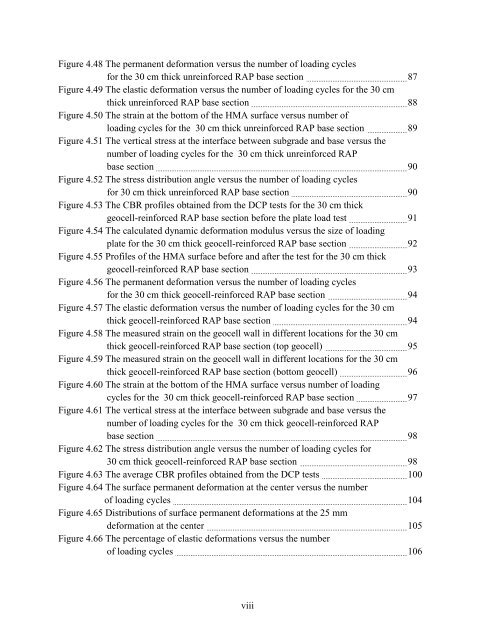Onsite Use of Recycled Asphalt Pavement Materials and Geocells to ...
Onsite Use of Recycled Asphalt Pavement Materials and Geocells to ...
Onsite Use of Recycled Asphalt Pavement Materials and Geocells to ...
Create successful ePaper yourself
Turn your PDF publications into a flip-book with our unique Google optimized e-Paper software.
Figure 4.48 The permanent deformation versus the number <strong>of</strong> loading cycles<br />
for the 30 cm thick unreinforced RAP base section 87<br />
Figure 4.49 The elastic deformation versus the number <strong>of</strong> loading cycles for the 30 cm<br />
thick unreinforced RAP base section 88<br />
Figure 4.50 The strain at the bot<strong>to</strong>m <strong>of</strong> the HMA surface versus number <strong>of</strong><br />
loading cycles for the 30 cm thick unreinforced RAP base section 89<br />
Figure 4.51 The vertical stress at the interface between subgrade <strong>and</strong> base versus the<br />
number <strong>of</strong> loading cycles for the 30 cm thick unreinforced RAP<br />
base section 90<br />
Figure 4.52 The stress distribution angle versus the number <strong>of</strong> loading cycles<br />
for 30 cm thick unreinforced RAP base section 90<br />
Figure 4.53 The CBR pr<strong>of</strong>iles obtained from the DCP tests for the 30 cm thick<br />
geocell-reinforced RAP base section before the plate load test 91<br />
Figure 4.54 The calculated dynamic deformation modulus versus the size <strong>of</strong> loading<br />
plate for the 30 cm thick geocell-reinforced RAP base section 92<br />
Figure 4.55 Pr<strong>of</strong>iles <strong>of</strong> the HMA surface before <strong>and</strong> after the test for the 30 cm thick<br />
geocell-reinforced RAP base section 93<br />
Figure 4.56 The permanent deformation versus the number <strong>of</strong> loading cycles<br />
for the 30 cm thick geocell-reinforced RAP base section 94<br />
Figure 4.57 The elastic deformation versus the number <strong>of</strong> loading cycles for the 30 cm<br />
thick geocell-reinforced RAP base section 94<br />
Figure 4.58 The measured strain on the geocell wall in different locations for the 30 cm<br />
thick geocell-reinforced RAP base section (<strong>to</strong>p geocell) 95<br />
Figure 4.59 The measured strain on the geocell wall in different locations for the 30 cm<br />
thick geocell-reinforced RAP base section (bot<strong>to</strong>m geocell) 96<br />
Figure 4.60 The strain at the bot<strong>to</strong>m <strong>of</strong> the HMA surface versus number <strong>of</strong> loading<br />
cycles for the 30 cm thick geocell-reinforced RAP base section 97<br />
Figure 4.61 The vertical stress at the interface between subgrade <strong>and</strong> base versus the<br />
number <strong>of</strong> loading cycles for the 30 cm thick geocell-reinforced RAP<br />
base section 98<br />
Figure 4.62 The stress distribution angle versus the number <strong>of</strong> loading cycles for<br />
30 cm thick geocell-reinforced RAP base section 98<br />
Figure 4.63 The average CBR pr<strong>of</strong>iles obtained from the DCP tests 100<br />
Figure 4.64 The surface permanent deformation at the center versus the number<br />
<strong>of</strong> loading cycles 104<br />
Figure 4.65 Distributions <strong>of</strong> surface permanent deformations at the 25 mm<br />
deformation at the center 105<br />
Figure 4.66 The percentage <strong>of</strong> elastic deformations versus the number<br />
<strong>of</strong> loading cycles 106<br />
viii
















